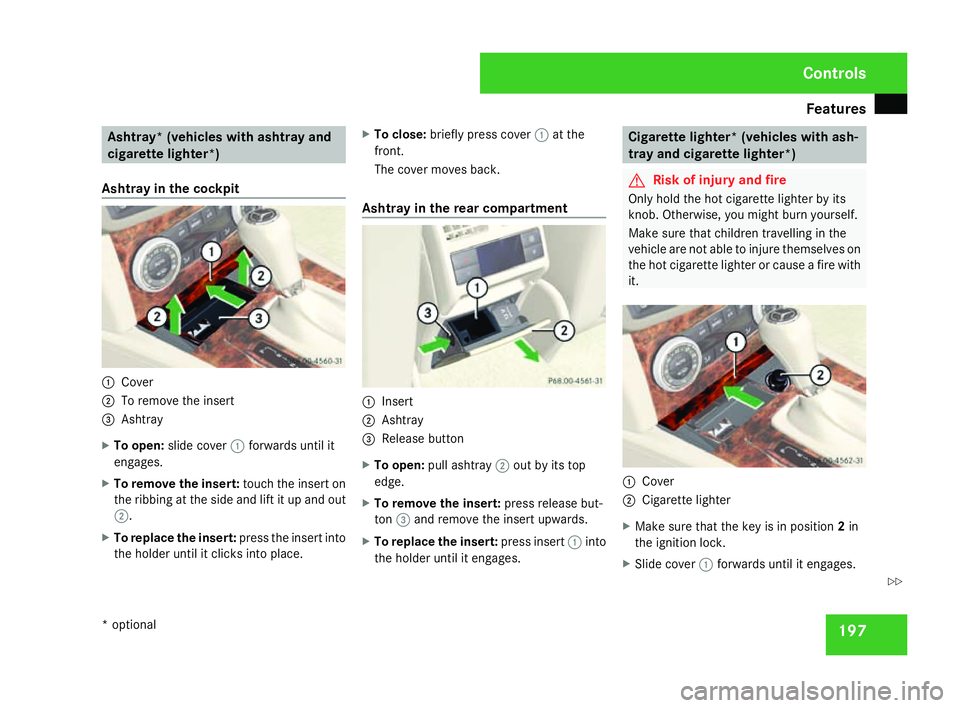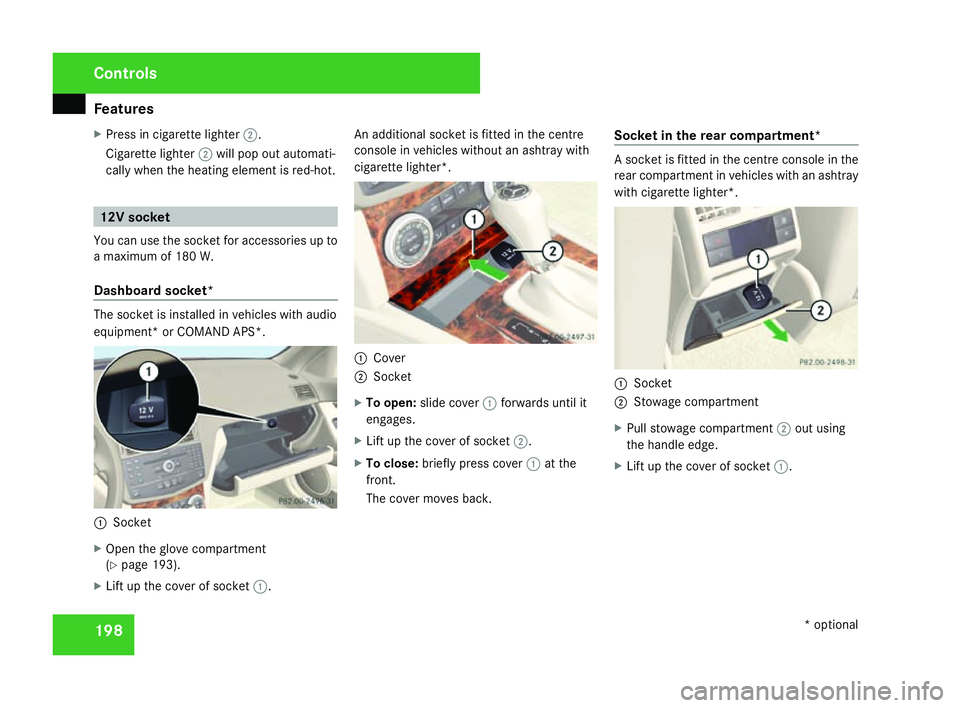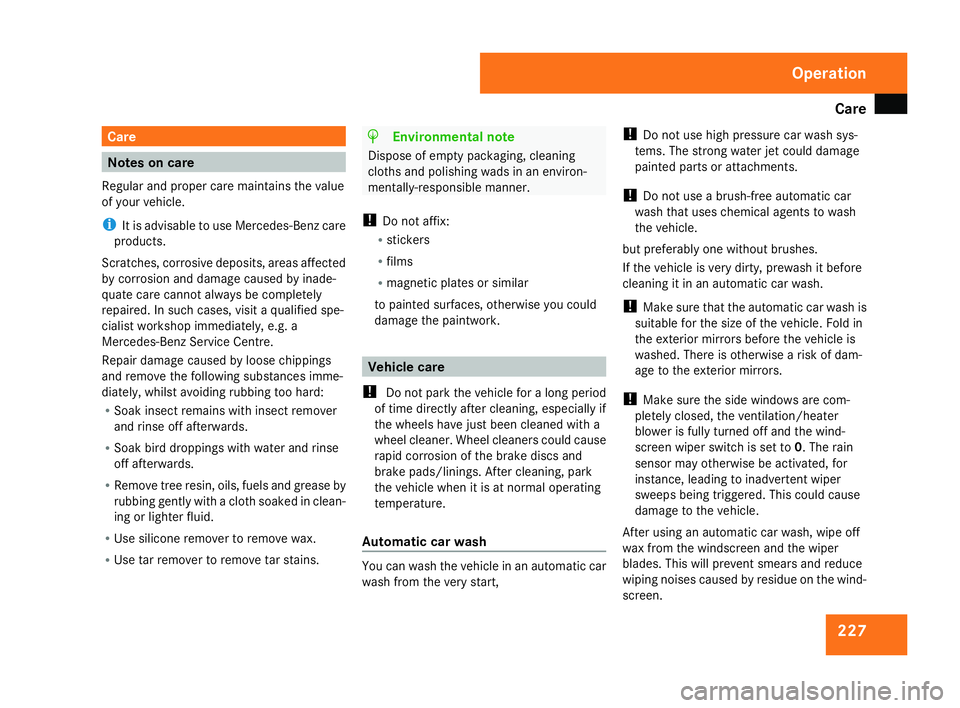2007 MERCEDES-BENZ C-CLASS SALOON light
[x] Cancel search: lightPage 199 of 377

Features
196
Mirror in the sun viso
rMirror light
1only comes on if the sun visor
is clipped into retainer 2and mirror cover
5 has been folded up.
Glare from the side X
Fold down the sun visor.
X Pull the sun visor from retainer 2.
X Swing the sun visor to the side. Roller sunblinds* for the rear side
windows 1
Tab
2 Retainers X
To extend: pull the roller sunblind out by
tab 1and hook it onto retainers 2at th e
top of the window.
! Always guide the roller sunblind by hand.
Do not let it snap back suddenly, as thi s
would damage the automatic roller mech-
anism.
! If you drive with the roller sunblind exten-
ded and the window open, the roller sun-
blind may pop out of the retainer and
suddenly spring back if you drive at high
speeds, e.g. on the motorway. This could
damage the inertia reel. Therefore, either
close the window or retract the roller sun-
blind before driving at high speeds. Rear window blind* (Saloon
) 1
Button for rear window blind
! Make sure that the rear window blind can
move freely. Otherwise, the blind or othe r
objects could be damaged.
X To extend or retract: briefly press button
1 .
The rear window blind fully extends or fully
retracts. Controls
* optional
204_AKB; 2; 3, en-GB
mkalafa,
2007-06-26T23:11:51+02:00 - Seite 196
Page 200 of 377

Features
197Ashtray* (vehicles with ashtray and
cigarette lighter*)
Ashtray in the cockpit 1
Cove r
2 To remove the insert
3 Ashtray
X To open: slide cover 1forwards until it
engages.
X To remove the insert: touch the insert on
the ribbing at the side and lift it up and ou t
2 .
X To replace the insert: press the insert into
the holder until it clicks into place .X
To close: briefly press cover 1at th e
front.
The cover moves back.
Ashtray in the rear compartment 1
Insert
2 Ashtray
3 Release butto n
X To open: pull ashtray 2out by its top
edge.
X To remove the insert: press release but-
ton 3and remove the insert upwards .
X To replace the insert: press insert1into
the holder until it engages . Cigarette lighter* (vehicles with ash
-
tray and cigarette lighter*) G
Risk of injury and fire
Only hold the hot cigarette lighter by its
knob. Otherwise, you might burn yourself.
Make sure that children travelling in the
vehicle are not able to injure themselves on
the hot cigarette lighter or cause a fire with
it. 1
Cove r
2 Cigarette lighter
X Make sure that the key is in position 2in
the ignition lock .
X Slide cover 1forwards until it engages. Controls
* optional
204_AKB; 2; 3, en-GB
mkalafa,
2007-06-26T23:11:51+02:00 - Seite 197 Z
Page 201 of 377

Features
198
X
Press in cigarette lighter 2.
Cigarette lighter 2will pop out automati-
cally when the heating element is red-hot .12V socket
You can use the socket for accessories up to
a maximum of 180 W.
Dashboard socket* The socket is installed in vehicles with audio
equipment* or COMAND APS*.
1
Socket
X Open the glove compartment
(Y page 193).
X Lift up the cover of socket 1. An additional socket is fitted in the centre
console in vehicles without an ashtray with
cigarette lighter*.
1
Cove r
2 Socket
X To open: slide cover 1forwards until it
engages.
X Lift up the cover of socket 2.
X To close: briefly press cover 1at th e
front.
The cover moves back. Socket in the rear compartment* A socket is fitted in the centre console in the
rear compartment in vehicles with an ashtra
y
with cigarette lighter* . 1
Socket
2 Stowage compartment
X Pull stowage compartment 2out using
the handle edge.
X Lift up the cover of socket 1. Cont
rols
* optional
204_AKB; 2; 3, en-GB
mkalafa,
2007-06-26T23:11:51+02:00 - Seite 198
Page 207 of 377

Refuelling
20
4 The first 1,500 km
If you treat the engine with sufficient car e
from the very start, it will reward you with
excellent performance for a very long period
afterwards .
R You should therefore drive at varying road
and engine speeds for the first 1,500 km.
R Avoid heavy loads, e.g. driving at full throt-
tle, during this time. Do not exceed 2
/ 3 of
the maximum permissible engine speed for
each gear.
R Change gear in good time.
R Do not shift down a gear manually in order
to brake.
Vehicles with automatic transmission* :
R Try to avoid depressing the accelerator
pedal beyond the pressure point (kick -
down).
R Only use ranges 3,2 or 1for slow driving,
e.g. in mountainous terrain. Refuellin
g Refuelling
G
Risk of explosion
Fuel is highly flammable. Fire, naked flames
and smoking are therefore prohibited when
handling fuels.
Switch off the engine before refuelling. G
Risk of injury
Avoid any contact with fuels.
You can damage your health if your skin
comes into direct contact with fuel or if yo u
inhale the vapour. G
Risk of fire
Do not use petrol to refuel vehicles with a
diesel engine. Never mix diesel with petrol.
This would damage the fuel system and
engine and could result in a vehicle fire.
! Do not use petrol to refuel vehicles with a
diesel engine. Do not use diesel to refuel
vehicles with a petrol engine. Never mix
diesel with petrol. Even small amounts of
the wrong fuel will damage the injection
system. Damage resulting from adding the
wrong fuel is not covered by the warranty. !
Do not start the engine if you accidentally
refuelled with the wrong fuel. Otherwise
you risk engine damage. Have the fuel sys-
tem emptied completely.
When you open or close the vehicle with the
key or KEYLESS GO*, the fuel filler flap is
automatically unlocked or locked.
The fuel filler flap is to the rear on the right . 1
To open the fuel filler flap
2 To insert the fuel filler cap
3 Tyre pressure table
4 Fuel typ e
X Remove the key from the ignition lock.
X To open: Press the fuel filler flap in the
direction of arrow 1.
The fuel filler flap opens slightly. Operation
* optional
204_AKB; 2; 3, en-GB
mkalafa,
2007-06-26T23:11:51+02:00 - Seite 204
Page 221 of 377

Driving
tips 21
8
Downhill gradient
sOn long and steep downhill stretches, espe-
cially if the vehicle is laden or towing a trailer,
you must shift to a lower gear in good time or,
on vehicles with automatic transmission*,
select shift range 1,2 or 3.
i This also applies if you have activated
cruise control* or Speedtronic*.
This uses the braking effect of the engine and
you will not have to brake to such an exten t
to maintain the same speed. This relieves the
load on the brake system and prevents the
brakes from overheating and wearing too
quickly. If you need additional braking ,
depress the brake pedal repeatedly rather
than continuously.
Heavy and light loads If the brakes have been subjected to a heavy
load, do not stop the vehicle immediately, but
drive on for a short while. This allows the air-
flow to cool the brakes more quickly. G
Risk of accident
Never depress the brake pedal continu -
ously while the vehicle is in motion, e.g.
never cause the brakes to rub by applying constant slight pedal pressure. This causes
the brake system to overheat, increases
the braking distance and can lead to the
brakes failing completely.
If the brakes have been used only moderately,
you should occasionally test their effective-
ness. To do this, brake more firmly from a
higher speed. This improves the grip of the
brakes.
Wet roads If you drive for a long time in the rain without
braking, there may be a delayed reaction
when you first brake and you will have to
depress the pedal harder.
You must therefore maintain a greater dis-
tance from the vehicle in front.
Brake firmly after driving on a wet road. Thi
s
way the brake discs will become warm, dryin g
more quickly, which will protect them against
corrosion. Limited braking performance on salted
roads G
Risk of accident
The layer of salt on the brake discs and the
brake linings may cause a delay in the brak-
ing effect, resulting in a significantly longer
braking distance, which could lead to an
accident.
To avoid this danger, you should:
R occasionally brake carefully when you
are driving on salted roads, so that any
layer of salt that may have started to
build up on the brake discs and the brake
linings is removed without putting other
road users at risk.
R maintain a greater distance to the vehicl e
ahead and drive with particular car e
R carefully apply the brakes at the end of a
trip and immediately after commencing a
new trip, so that salt residues ar e
removed from the brake disc.
New brake linings For safety reasons, Mercedes-Benz recom
-
mends that you have only brake pads/linings
fitted to your vehicle that have been approved Operation
* optional
204_AKB; 2; 3, en-GB
mkalafa,
2007-06-26T23:11:51+02:00 - Seite 218
Page 222 of 377

Driving
tips 21
9
for Mercedes-Benz vehicles or which corre-
spond to an equivalent quality standard.
Brake pads/linings which have not been
approved for Mercedes-Benz or which which
are not of an equivalent quality could affect
your vehicle's operating safety. G
Risk of accident
New brake linings only reach their optimum
braking effect after several hundred kilo-
metres of driving. Before this optimum
braking effect is reached, you should com-
pensate for the reduced braking effect by
applying greater pressure when braking.
This also applies after the brake discs or the
brake linings have been replaced .Tyre gri
p G
Risk of accident
Whereas the vehicle can be fully controlle d
at a certain speed on dry roads, you must
reduce your speed on wet or icy roads to
achieve the same road safety. Otherwise
you could cause an accident.
Pay particular attention to the road condi-
tions at temperatures around freezing
point. If ice has formed on the road surface (e.g.
from fog), a light film of water rapidly forms
on the ice when you brake, considerably
reducing tyre grip. Drive with particular
care in such weather conditions.
Driving on wet roads
If water has accumulated to a certain dept h
on the road surface, there is a danger of aqua-
planing occurring, even if:
R you drive at low speeds
R the tyres have adequate tread depth
For this reason, do not drive in tyre ruts, and
brake carefully. Driving on flooded roads
If you have to drive on stretches of road on
which water has collected, please bear in
mind that:
R the maximum permitted still water depth is
25 cm.
R you should drive no faster than at walkin g
pace.
! Bear in mind that vehicles travelling in
front or in the opposite direction creat e
waves. This may cause the maximum per-
missible water depth to be exceeded.
You must observe these notes, otherwise
damage may occur to the engine, electrics
and transmission . Operation
204_AKB; 2; 3, en-GB
mkalafa,
2007-06-26T23:11:51+02:00 - Seite 219
Page 226 of 377

Trailer towing*
22
3
R
has an increased braking distance
R is affected more by strong crosswinds
R demands more sensitive steering
R consumes more fue l
On long and steep downhill gradients you
must select a lower gear in good time, or on
vehicles with automatic transmission*, select
the shift range 1,2 or 3.
i This also applies if you have activated
cruise control* or Speedtronic*.
This uses the braking effect of the engine and
you will not have to brake to such an exten t
to maintain the same speed. This relieves the
load on the brake system and prevents the
brakes from overheating and wearing too
quickly. If you need additional braking ,
depress the brake pedal repeatedly rather
than continuously. G
Risk of accident
Never depress the brake pedal continu -
ously while the vehicle is in motion, e.g.
never cause the brakes to rub by applying
constant slight pedal pressure. This causes
the brake system to overheat, increases
the braking distance and can lead to the
brakes failing completely. Driving tips
R
Maintain a greater distance from the vehi-
cle in front than when driving without a
trailer.
R Avoid braking abruptly. If possible, brake
gently at first to allow the trailer to run on.
Then increase the braking force rapidly.
R The values given for gradient-climbing
capabilities from a standstill refer to sea
level. When driving in mountainous areas,
note that the power output of the engine
and with it its gradient-climbing capability
decrease with increasing altitude.
If the trailer swings from side to side:
X Do not accelerate.
X Do not counter-steer.
X Brake if necessary. G
Risk of accident
On no account should you attempt to dra w
the vehicle/trailer combination out by
increasing speed. Folding in the ball couplin
g
i Fold in the ball coupling when you are not
using the trailer tow hitch . G
Risk of injury
Make sure that no persons or animals are
in the pivoting range of the ball coupling.
Otherwise, they could be injured .
The release wheel is located behind the side
trim panel in the boot/luggage compartment. Saloon
1 Handl e
2 Cove r Operation
* optional
204_AKB; 2; 3, en-GB
mkalafa,
2007-06-26T23:11:51+02:00 - Seite 223
Page 230 of 377

Car
e 227Care
Notes on care
Regular and proper care maintains the value
of your vehicle.
i It is advisable to use Mercedes-Benz care
products.
Scratches, corrosive deposits, areas affected
by corrosion and damage caused by inade-
quate care cannot always be completely
repaired. In such cases, visit a qualified spe-
cialist workshop immediately, e.g. a
Mercedes-Benz Service Centre.
Repair damage caused by loose chippings
and remove the following substances imme-
diately, whilst avoiding rubbing too hard:
R Soak insect remains with insect remover
and rinse off afterwards .
R Soak bird droppings with water and rins e
off afterwards.
R Remove tree resin, oils, fuels and grease by
rubbing gently with a cloth soaked in clean-
ing or lighter fluid .
R Use silicone remover to remove wax.
R Use tar remover to remove tar stains. H
Environmental not
e
Dispose of empty packaging, cleaning
cloths and polishing wads in an environ-
mentally-responsible manner.
! Do not affix :
R stickers
R films
R magnetic plates or similar
to painted surfaces, otherwise you could
damage the paintwork. Vehicle care
! Do not park the vehicle for a long perio d
of time directly after cleaning, especially if
the wheels have just been cleaned with a
wheel cleaner. Wheel cleaners could cause
rapid corrosion of the brake discs and
brake pads/linings. After cleaning, park
the vehicle when it is at normal operatin g
temperature.
Automatic car wash You can wash the vehicle in an automatic car
wash from the very start,!
Do not use high pressure car wash sys-
tems. The strong water jet could damage
painted parts or attachments.
! Do not use a brush-free automatic car
wash that uses chemical agents to wash
the vehicle.
but preferably one without brushes.
If the vehicle is very dirty, prewash it befor e
cleaning it in an automatic car wash.
! Make sure that the automatic car wash is
suitable for the size of the vehicle. Fold in
the exterior mirrors before the vehicle is
washed. There is otherwise a risk of dam-
age to the exterior mirrors.
! Make sure the side windows are com-
pletely closed, the ventilation/heater
blower is fully turned off and the wind-
screen wiper switch is set to 0. The rai n
sensor may otherwise be activated, for
instance, leading to inadvertent wiper
sweeps being triggered. This could cause
damage to the vehicle.
After using an automatic car wash, wipe off
wax from the windscreen and the wiper
blades. This will prevent smears and reduce
wiping noises caused by residue on the wind-
screen. Operation
204_AKB; 2; 3, en-GB
mkalafa,
2007-06-26T23:11:51+02:00 - Seite 227